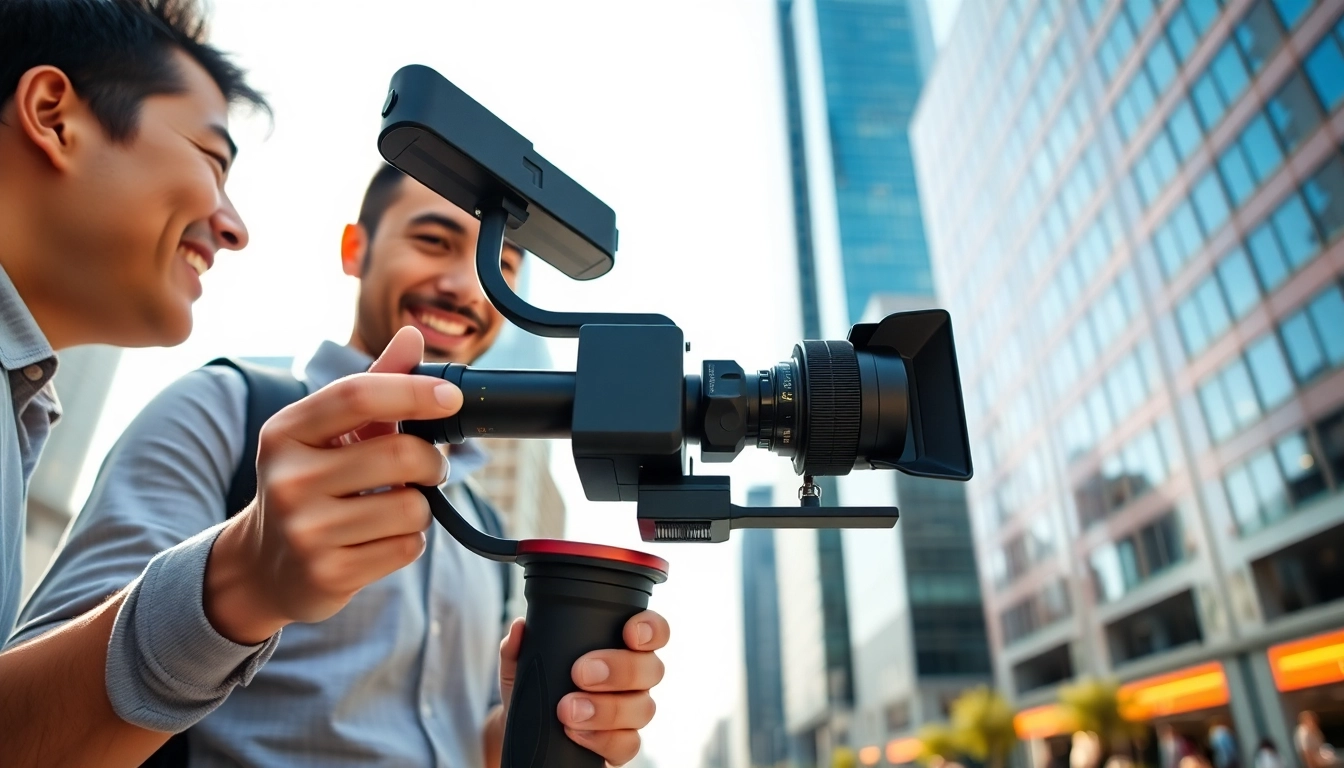The Basics of Handheld Gimbal Use
What is a Handheld Gimbal?
A handheld gimbal is a device used to stabilize cameras and smartphones when filming video or capturing images. Unlike traditional tripods, which offer stability solely when stationary, gimbals are designed to maintain balance while in motion. They work on a pivot mechanism that uses motors and sensors to counteract undesired camera movements, allowing for smooth, shake-free footage in dynamic environments. This technology has revolutionized how filmmakers, vloggers, and content creators capture high-quality videos, making gimbals an essential tool in their arsenal.
Key Features of a Handheld Gimbal
Handheld gimbals come equipped with several features that enhance their usability and effectiveness. Some of these key features include:
- 3-Axis Stabilization: This allows the gimbal to counteract pitch, yaw, and roll motion, providing superior stabilization for a range of shooting scenarios.
- Adjustable Settings: Many gimbals offer customizable settings such as motor strength and speed, making them versatile for different filming styles.
- Battery Life: Long-lasting batteries ensure that users can film for extended periods without interruption, essential for events or travel.
- Lightweight and Portable: Designed for easy carry, handheld gimbals are often compact, making them ideal for location shoots.
- Smartphone Compatibility: Many models are built to accommodate various smartphone sizes, with quick-lock mechanisms for ease of use.
Understanding Stabilization Technology
The technology behind handheld gimbals is primarily based on gyroscopes and accelerometers, which help to detect motion and adjust the gimbal’s motors correspondingly. Understanding these components is key for every user:
- Gyroscopes: Devices that measure angular velocity, enabling the gimbal to sense changes in orientation and adjust quickly to maintain stability.
- Accelerometers: Sensors that gauge changes in speed and direction, helping to refine the stabilization corrections when moving.
- Motor Control: The responsiveness of a gimbal is influenced by its motor control algorithms, which dictate how precisely and rapidly it can adjust based on imbalances.
Choosing the Right Handheld Gimbal
Factors to Consider Before Purchase
When purchasing a handheld gimbal, there are several factors to consider to ensure that you select the right model for your needs:
- Weight and Size: Consider how portable you need your gimbal to be. Lighter models are easier to transport, but may lack some features found in heavier counterparts.
- Payload Capacity: Make sure the gimbal can support the weight of your camera or smartphone, as exceeding this limit can damage the device.
- Features and Functionality: Look for features that cater to your filming style. Some gimbals offer preset modes like ‘inception’ or ‘panorama’ for versatile shooting.
- Ease of Use: Especially for beginners, intuitive controls can make a significant difference in capturing quality footage without a steep learning curve.
Comparing Different Models
There is a wide array of handheld gimbals available on the market, each offering unique features and benefits. Researching and comparing different models based on user reviews, expert recommendations, and demonstrated performance can help identify the best fit. Be sure to focus on:
- Stabilization performance (3-axis vs. 2-axis).
- The availability of accessories such as tripods or extension rods.
- Battery life during continuous use.
- Built-in features, such as tracking or motion time-lapse capabilities.
Budgeting for Your Handheld Gimbal
Your budget will significantly influence your choice of handheld gimbal. While it’s essential to consider cost, prioritizing quality and capabilities is crucial. Mid-range models often provide the best balance between affordability and functionality. Here are some tips for budgeting:
- Set Clear Financial Limits: Determine how much you’re willing to spend before you start shopping.
- Prioritize Features: Identify key features you need, so you can focus on gimbals that provide value for your investment.
- Look for Sales: Keeping an eye on discounts or promotions can help you get a better deal on high-quality models.
Best Practices for Using a Handheld Gimbal
Settings for Optimal Performance
To get the most out of your handheld gimbal, adjusting the settings according to your shooting conditions is vital. Here are some optimal settings and practices:
- Motor Strength: Increase motor strength when shooting in windy conditions or with heavier equipment.
- Calibration: Regularly calibrate your gimbal before shooting to ensure precise balance and stability.
- Mode Selection: Utilize different operational modes like ‘Follow Mode’ for smooth panning shots or ‘Lock Mode’ for static framing.
Techniques for Smooth Filming
Implementing proper filming techniques is key to maximizing the capabilities of a handheld gimbal. Here are a few recommended techniques:
- Engage the Elbows: For better stability, tuck your elbows into your body, creating a strong, steady base.
- Use Slow and Steady Movements: Abrupt movements can still cause shakiness; practice smooth transitions to maintain steadiness.
- Walk Smoothly: If filming while moving, practice a soft, gliding walk rather than bouncing up and down.
Common Mistakes to Avoid
Even experienced users can fall into traps that undermine their shooting efforts. To avoid common pitfalls:
- Ignoring Battery Levels: Always check battery levels before a shoot to prevent disruptions.
- Inadequate Testing: Don’t skip the pre-setup checks; take test shots to ensure everything is functioning well.
- Not Utilizing Features: Many users fail to fully utilize the features of their gimbals. Take time to learn the available settings and modes.
Advanced Techniques with a Handheld Gimbal
Cinematic Movements to Try
Elevate your storytelling with advanced filming techniques using a handheld gimbal. Here are a few cinematic movements worth exploring:
- Dolly Zoom: A unique visual effect achieved by zooming in while physically moving away from a subject, creating a striking depth perception.
- 360-Degree Pans: Slow horizontal pans around a subject can create a sense of immersion and drama in your footage.
- Crane Shots: Utilize height to your advantage by transitioning from a low shot to a high angle smoothly.
Incorporating Creative Angles
Experimenting with dynamic angles can elevate your video from basic to breathtaking. Here are some tips on incorporating creative angles:
- Low Angles: Shooting from below your subject can create a powerful, imposing impression.
- Overhead Shots: Capture the scene from above to provide contextual views and interesting narratives.
- Close-ups: Zoom in to create intimacy and focus on details that might otherwise go unnoticed.
Editing Your Footage for Impact
The editing process is as crucial as filming. Integrating your footage effectively requires consideration of several factors:
- Use Transitions Wisely: Match your transitions to the mood of your footage: softer cuts for emotional moments, or quick cuts for action sequences.
- Color Grading: Apply color correction to maintain consistency across shots and enhance the overall feel of your video.
- Syncing with Music: Aligning cuts with beats in a soundtrack can elevate engagement and emotional response.
Maintaining Your Handheld Gimbal
Cleaning and Care Tips
Proper maintenance of your handheld gimbal ensures its longevity and performance. Here are some tips:
- Regular Cleaning: Use a soft cloth to wipe down surfaces and remove dirt after each use.
- Store Properly: When not in use, keep the gimbal in a protective case to avoid physical damage.
- Avoid Water Exposure: Protect electronic components from moisture; using a silica gel pack can help absorb humidity during storage.
Upgrading Options for Longevity
As technology evolves, so do the features of gimbals. Consider upgrading components to enhance your device:
- Batteries: Opt for higher-capacity battery packs for longer filming sessions.
- Firmware Updates: Regularly check for firmware updates, which can enhance performance and add new features.
- Accessories: Invest in additional accessories such as external microphones or filters to optimize overall shooting quality.
Troubleshooting Common Issues
Occasionally, you may encounter issues with your handheld gimbal. Here are solutions for common problems:
- Battery Draining Quickly: If your battery life seems too short, check for outdated software or consider replacing the battery.
- Lagging or Unresponsive Controls: Restart your gimbal to reset the sensor systems, and ensure it’s calibrated correctly.
- Strange Noises: Grinding or rattling sounds can indicate that dust has entered the motors; cleaning may be required.



